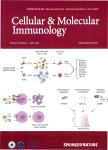Immune regulatory networks coordinated by glycans and glycan-binding proteins in autoimmunity and infection
作者机构:i3S–Institute for Research and Innovation in HealthUniversity of Porto4200-135PortoPortugal ICBAS-School of Medicine and Biomedical SciencesUniversity of Porto4050-313PortoPortugal Faculty of MedicineUniversity of Porto4200-319PortoPortugal Laboratorio de GlicomedicinaInstituto de Biología y Medicina Experimental(IBYME)Consejo Nacional de Investigaciones Científicas y Técnicas(CONICET)C1428Ciudad de Buenos AiresArgentina Facultad de Ciencias Exactas y NaturalesUniversidad de Buenos AiresC1428Ciudad de Buenos AiresArgentina
出 版 物:《Cellular & Molecular Immunology》 (中国免疫学杂志(英文版))
年 卷 期:2023年第20卷第10期
页 面:1101-1113页
核心收录:
学科分类:1001[医学-基础医学(可授医学、理学学位)] 100102[医学-免疫学] 10[医学]
基 金:supported by grants from SSP:co-funded by the European Union(ERC GlycanSwitch 101071386).Views and opinions expressed are however those of the author(s)only and do not necessarily reflect those of the European Union or the European Research Council Executive Agency.Neither the European Union nor the granting authority can be held responsible for them.The work was also co-funded by EU GlycanTrigger-grant Agreement No:101093997.Views and opinions expressed are however those of the author(s)only and do not necessarily reflect those of the European Union or European Health and Digital Executive Agency.Neither the European Union nor the granting authority can be held responsible for them.SSP also acknowledges funding by“2022 LRA Lupus Innovation Award”and by“European Crohn’s and Colitis Organisation(ECCO)Pioneer Award 2021”.SSP also acknowledges the US Department of Defense US Army Medical Research Acquisition Activity FY18 Peer Reviewed Medical Research Program Investigator-Initiated Research Award(award number W81XWH1920053)as well as grant funded by the Portuguese Foundation for Science and Technology–FCT(EXPL/MED-ONC/0496/2021).IA acknowledges FCT for funding(2022.00337.CEECIND).JG acknowledges funding from ESCMID(ESCMID Research Grant 2022) ECCO(ECCO Grant 2023)and FCT(2020.00088.CEECIND).G.A.R acknowledges grants from the Argentinean Agency for Promotion of Science Technology and Innovation(PICT 2017-0494 PICT-FBB 620 and PICT 2020-01552).The authors are also thankful for generous support from Sales(Argentina) Bunge&Born(Argentina) Baron(Argentina) Williams(Argentina)and Richard Lounsbery(USA)Foundations as well as donations from Ferioli-Ostry and Caraballo families to GAR
主 题:Immune response Inflammation Infection Glycans Glycosylation Glycan-binding proteins
摘 要:The immune system is coordinated by an intricate network of stimulatory and inhibitory circuits that regulate host responses against endogenous and exogenous *** of these safeguard and homeostatic mechanisms can lead to unpredictable inflammatory and autoimmune responses,whereas deficiency of immune stimulatory pathways may orchestrate immunosuppressive programs that contribute to perpetuate chronic infections,but also influence cancer development and *** have emerged as essential components of homeostatic circuits,acting as fine-tuners of immunological responses and potential molecular targets for manipulation of immune tolerance and activation in a wide range of pathologic *** surface glycans,present in cells,tissues and the extracellular matrix,have been proposed to serve as“self-associated molecular patternsthat store structurally relevant biological *** responsibility of deciphering this information relies on different families of glycan-binding proteins(including galectins,siglecs and C-type lectins)which,upon recognition of specific carbohydrate structures,can recalibrate the magnitude,nature and fate of immune *** process is tightly regulated by the diversity of glycan structures and the establishment of multivalent interactions on cell surface receptors and the extracellular *** we review the spatiotemporal regulation of selected glycan-modifying processes including mannosylation,complex N-glycan branching,core 2 O-glycan elongation,LacNAc extension,as well as terminal sialylation and ***,we illustrate examples that highlight the contribution of these processes to the control of immune responses and their integration with canonical tolerogenic ***,we discuss the power of glycans and glycan-binding proteins as a source of immunomodulatory signals that could be leveraged for the treatment of autoimmune inflammation and chronic infection.



